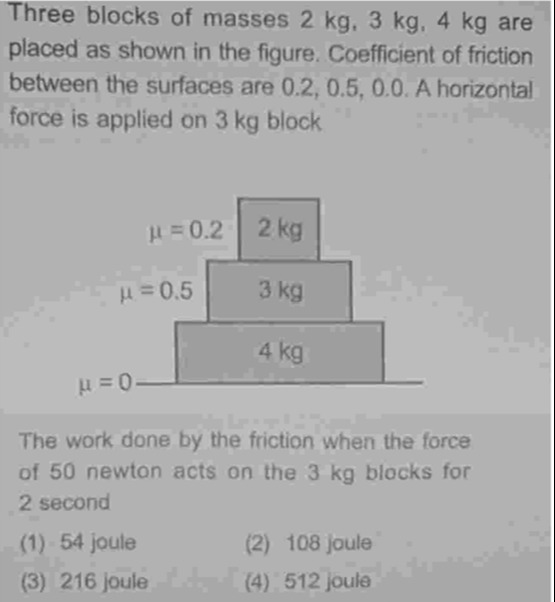Question
Question: Three blocks of masses 2 kg, 3 kg, 4 kg are placed as shown in the figure. Coefficient of friction b...
Three blocks of masses 2 kg, 3 kg, 4 kg are placed as shown in the figure. Coefficient of friction between the surfaces are 0.2, 0.5, 0.0. A horizontal force is applied on 3 kg block
The work done by the friction when the force of 50 newton acts on the 3 kg blocks for 2 second

54 joule
108 joule
216 joule
512 joule
108 joule
Solution
The problem involves three blocks stacked on top of each other with different coefficients of friction between the surfaces. A horizontal force of 50 N is applied to the 3 kg block. We need to find the work done by friction in 2 seconds.
Let m1=2 kg, m2=3 kg, m3=4 kg. Coefficients of friction: μ1=0.2 (between 2 kg and 3 kg), μ2=0.5 (between 3 kg and 4 kg), μ3=0.0 (between 4 kg and ground). Applied force F=50 N on the 3 kg block. Time t=2 s. Use g=10 m/s2.
First, determine if the blocks move together or slide relative to each other. Maximum static friction between 2 kg and 3 kg: fs1,max=μ1m1g=0.2×2×10=4 N. Maximum static friction between 3 kg and 4 kg: fs2,max=μ2(m1+m2)g=0.5×(2+3)×10=0.5×50=25 N. Maximum static friction between 4 kg and ground: fs3,max=μ3(m1+m2+m3)g=0.0×(2+3+4)×10=0 N.
Assume all blocks move together with acceleration a. Total mass M=2+3+4=9 kg. F=Ma⟹50=9a⟹a=950 m/s2. Required friction on 2 kg from 3 kg is f1=m1a=2×950=9100≈11.11 N. Since f1>fs1,max (11.11 N > 4 N), the 2 kg block slides relative to the 3 kg block. The friction between 2 kg and 3 kg is kinetic friction: fk1=μ1m1g=4 N. This force is on 2 kg in the direction of motion and on 3 kg opposite to the relative motion.
Now consider the 2 kg block. The only horizontal force is fk1 from the 3 kg block. fk1=m1a1⟹4=2a1⟹a1=2 m/s2.
Now consider the 3 kg and 4 kg blocks. Let's assume they move together with acceleration a23. The forces on the combined (3+4) kg system are the applied force F, the kinetic friction from the 2 kg block on the 3 kg block (fk1 backward), and the friction from the ground on the 4 kg block (f3). Since μ3=0, f3=0. The force on the 3 kg block from the 2 kg block is fk1 backward. The force on the 4 kg block from the 3 kg block is f2 forward. Consider the combined (3+4) kg system. The external horizontal forces are F and fk1 (backward). F−fk1=(m2+m3)a23 (This is incorrect because fk1 is an internal force in this combined system). Let's consider the forces on 3 kg and 4 kg separately. On 3 kg: F−fk1−f2=m2a2. 50−4−f2=3a2⟹46−f2=3a2. On 4 kg: f2−f3=m3a3. Since f3=0, f2=4a3. If 3 kg and 4 kg move together, a2=a3=a23. f2=4a23. 46−4a23=3a23⟹46=7a23⟹a23=746 m/s2. The required friction between 3 kg and 4 kg is f2=4a23=4×746=7184≈26.29 N. Since f2>fs2,max (26.29 N > 25 N), the 3 kg block slides relative to the 4 kg block. The friction between 3 kg and 4 kg is kinetic friction: fk2=μ2(m2+m1)g is incorrect. The normal force between 3kg and 4kg is from the weight of 2kg and 3kg blocks, so N2=(m1+m2)g. fk2=μ2N2=0.5×(2+3)×10=25 N. This force is on 3 kg opposite to its motion relative to 4 kg, and on 4 kg in the direction of motion of 3 kg relative to 4 kg.
Now, we have kinetic friction at both interfaces (2-3 and 3-4). Forces on 2 kg: fk1=4 N (forward). a1=m1fk1=24=2 m/s2. Forces on 3 kg: F=50 N (forward), fk1=4 N (backward from 2 kg), fk2=25 N (backward from 4 kg). F−fk1−fk2=m2a2⟹50−4−25=3a2⟹21=3a2⟹a2=7 m/s2. Forces on 4 kg: fk2=25 N (forward from 3 kg), fk3=0 N (from ground). fk2−fk3=m3a3⟹25−0=4a3⟹a3=425=6.25 m/s2.
Accelerations: a1=2 m/s2, a2=7 m/s2, a3=6.25 m/s2. Displacements after t=2 s (starting from rest): d1=21a1t2=21×2×22=4 m. d2=21a2t2=21×7×22=14 m. d3=21a3t2=21×6.25×22=12.5 m.
Work done by friction at the 2-3 interface: The friction force on 2 kg is fk1=4 N in the direction of motion. Work done on 2 kg is Wf1,2=fk1d1=4×4=16 J. The friction force on 3 kg is fk1=4 N opposite to the direction of motion. Work done on 3 kg is Wf1,3=−fk1d2=−4×14=−56 J. Total work done by friction at the 2-3 interface is Wf1=Wf1,2+Wf1,3=16−56=−40 J.
Work done by friction at the 3-4 interface: The friction force on 3 kg is fk2=25 N opposite to the direction of motion. Work done on 3 kg is Wf2,3=−fk2d2=−25×14=−350 J. The friction force on 4 kg is fk2=25 N in the direction of motion. Work done on 4 kg is Wf2,4=fk2d3=25×12.5=312.5 J. Total work done by friction at the 3-4 interface is Wf2=Wf2,3+Wf2,4=−350+312.5=−37.5 J.
Work done by friction at the 4-ground interface is 0 since the friction force is 0.
The total work done by friction is the sum of work done at each interface: Wfriction=Wf1+Wf2+Wf3=−40+(−37.5)+0=−77.5 J.
However, the options are positive. The question asks for the work done by the friction. This might mean the magnitude of the work done by the friction forces on the system or the sum of the absolute values of the work done by friction on each block. Let's check the options again. The options are 54, 108, 216, 512. None of these match -77.5.
